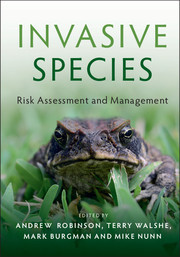Invasive Species Risk Assessment and Management
Langue : Anglais
Coordonnateurs : Robinson Andrew P., Walshe Terry, Burgman Mark A., Nunn Mike

This book reviews the latest risk-based techniques to protect national interests from invasive pests and pathogens before, at and within national borders.
With climate change and increasing globalisation of trade and travel, the risks presented by invasive pests and pathogens to natural environments, agriculture and economies have never been greater, and are only increasing with time. Governments world-wide are responding to these increased threats by strengthening quarantine and biosecurity. This book presents a comprehensive review of risk-based techniques that help policy makers and regulators protect national interests from invasive pests and pathogens before, at, and inside national borders. Selected from the research corpus of the Centre of Excellence for Biosecurity Risk Analysis at the University of Melbourne, this book provides solutions that reflect scientific rigour coupled with practical, hands-on applications. Focusing on surveillance, stochastic modelling, intelligence gathering, decision making and risk communication, the contents combine the strengths of risk analysts, mathematicians, economists, biologists and statisticians. The book presents tested scientific solutions to the greatest challenges faced by quarantine and biosecurity policy makers and regulators today.
1. The allocation of inspection resources Owen Jones, Andrew Robinson, Martin Shield and Jessica Sibley; 2. Tools for designing and evaluating post-border surveillance systems Susan M. Hester, Cindy E. Hauser and John M. Kean; 3. Control charts for biosecurity monitoring and surveillance David R. Fox; 4. Open-source intelligence gathering and open-analysis intelligence for biosecurity Geoff Grossel, Aidan Lyon and Mike Nunn; 5. Predicting distributions of invasive species Jane Elith; 6. Mapping risks and impacts of invasive alien species with dynamic simulation models Denys Yemshanov, Frank H. Koch, John W. Coulston and William D. Smith; 7. Models for understanding disease dynamics Michael P. Ward, M. Graeme Garner, Joanne M. Potts and Brendan D. Cowled; 8. Bayesian networks for import risk assessment Ann E. Nicholson and Kevin B. Korb; 9. Getting the message right: tools for improving biosecurity risk communication Jane Gilmour, Ruth Beilin, Tamara Sysak and Marta Hernández-Jover; 10. Cost–benefit analysis for biosecurity decisions Tom Kompas, Tuong Nhu Che, Pham Van Ha and Long Chu; 11. Valuing protection against invasive species using contingent valuation John Rolfe and Jill Windle; 12. Management of invasive species: info-gap perspectives Yakov Ben-Haim; 13. Decisions with relative robustness Colin J. Thompson; 14. Optimising resource allocation Cindy E. Hauser and Tracy M. Rout; 15. Value of information analysis as a decision support tool for biosecurity Michael C. Runge, Tracy M. Rout, Daniel A. Spring and Terry Walshe; 16. Declaring eradication of an invasive species Tracy M. Rout; 17. Surveillance for detection of pests and diseases – how sure can we be of their absence? Tony Martin; 18. Some questions to ask yourself Rob Cannon.
Andrew Robinson is a Reader and Associate Professor in applied statistics, and director of the Centre of Excellence for Biosecurity Risk Analysis (CEBRA), at the University of Melbourne. He works on biosecurity at national borders, inspection surveillance systems and performance metrics for regulatory inspectorates.
Terry Walshe is a Decision Scientist at the Australian Institute of Marine Science. His research deals with the intersection of technical and social dimensions of marine science and marine management.
Mark A. Burgman is Professor of Risk Analysis and Environmental Policy at the Centre for Environmental Policy, Imperial College London. He works on ecological modelling, conservation biology and risk assessment.
Mike Nunn is a Research Program Manager at the Australian Centre for International Agricultural Research (ACIAR). He has particular interests in epidemiology, risk analysis, emerging diseases, zoonoses, nutrition-sensitive agriculture, and strategic foresight.
Terry Walshe is a Decision Scientist at the Australian Institute of Marine Science. His research deals with the intersection of technical and social dimensions of marine science and marine management.
Mark A. Burgman is Professor of Risk Analysis and Environmental Policy at the Centre for Environmental Policy, Imperial College London. He works on ecological modelling, conservation biology and risk assessment.
Mike Nunn is a Research Program Manager at the Australian Centre for International Agricultural Research (ACIAR). He has particular interests in epidemiology, risk analysis, emerging diseases, zoonoses, nutrition-sensitive agriculture, and strategic foresight.
Date de parution : 06-2017
Ouvrage de 426 p.
17.8x25.3 cm
Disponible chez l'éditeur (délai d'approvisionnement : 14 jours).
Prix indicatif 120,27 €
Ajouter au panierDate de parution : 06-2017
Ouvrage de 426 p.
17.5x24.7 cm
Disponible chez l'éditeur (délai d'approvisionnement : 14 jours).
Prix indicatif 60,02 €
Ajouter au panierThèmes d’Invasive Species :
© 2024 LAVOISIER S.A.S.



